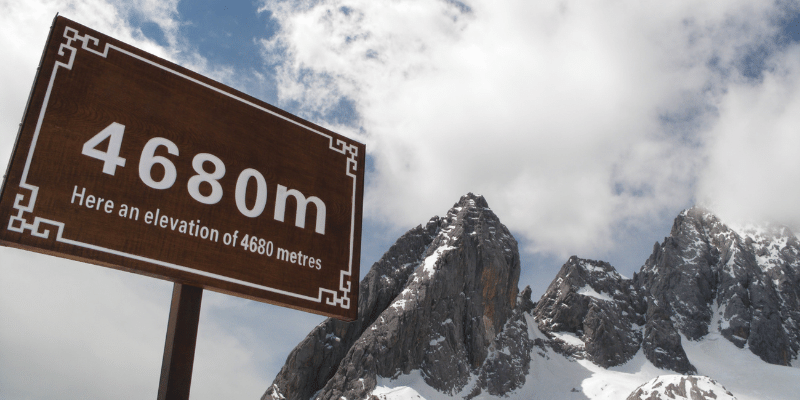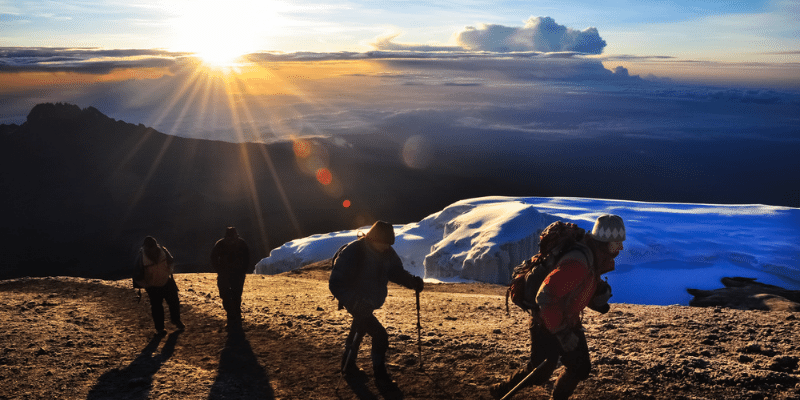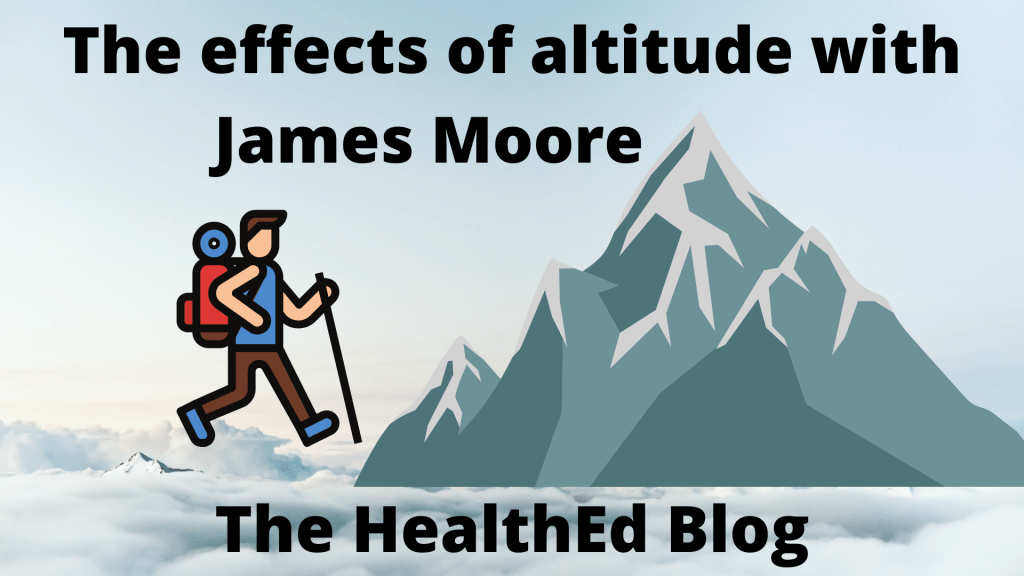
For the final part of this blog, we now need to consider some of the illnesses associated with trekking at high altitude, before coming up with some strategies to prevent and treat them.
There are three key illnesses associated with travelling to high-altitude, one which is common, known as Acute Mountain Sickness (AMS), and two which are severe, known as High-altitude cerebral oedema (HACE) and High-altitude pulmonary oedema (HAPE)
It is not uncommon for people to feel unwell as a result of being at altitude, something we call Acute Mountain Sickness (AMS). The range of symptoms were first described in medical literature in 1913, and included headaches, tiredness, nausea, loss of appetite, light-headedness and difficulty sleeping. These symptoms normally manifest themselves after being at altitude for 24-hours, and occur in over 80% of people travelling over 4,000m.
Several different mechanisms exist to measure the severity of these illnesses, the most common being the Lake Louise Score. However, they have been shown to over-report the illness whilst also having a poor specificity, as many of the symptoms can be attributed to common traveller illnesses. Despite these issues, many people still feel ill at altitude.
What about our 45-year-old trekker on Kilimanjaro – can we predict if they will get ill?

The main predictors for AMS are:
Therefore, if they walk slowly (at a pace they can have a conversation), don’t over-do it, and stay hydrated and healthy, they are less likely to get ill.
The main risk-factors for AMS are:
However, factors that do not appear to put individuals at risk of AMS include:
The treatment for AMS is to rest, rehydrate, take some pain-killers for any headaches and when feeling better, you can continue.

Although most people will experience some AMS symptoms, with a sensible acclimatisation programme and steady ascent, they will be able to complete their trek. Occasionally however, some individuals will end up with more serious conditions.
HACE (our American cousins spell Oedema without the ‘O’) is considered a continuation of AMS. i.e., someone who fails to acclimatise but continues ascending. There is a 1-2% incidence in HACE in those ascending rapidly over 3,000m.
The symptoms are similar to any form of cerebral oedema and include:
HACE is a result of high-altitude hypoxia causing cerebral vasodilation, increasing interstitial fluid and a consequent cerebral oedema. The treatment for HACE is oxygen, dexamethasone and rapid descent.
HAPE is a severe mountain illness affecting the lungs and occurs 12-36 hours after ascent. There is a 1-4% incidence in those ascending rapidly over 3,000m.
The symptoms are similar to any form of pulmonary oedema and include:
High-altitude pulmonary oedema is caused by uneven hypoxic vasoconstriction, which results in severe pulmonary hypertension and vascular stress leakages. The treatment for HAPE is oxygen, calcium channel blockers (e.g. Nifedipine) and rapid descent.
For all three of these high-altitude illnesses, the medical response should be the same: if you get sick at altitude, don’t go any higher until the symptoms resolve. If they don’t, or you develop HACE or HAPE, descend.

Now we know more about the high-altitude environment, respiratory physiology and high-altitude, and the three main altitude illnesses, we need to consider strategies to prevent problems occurring.
Other than advice regarding getting fit for travel, staying hydrated and well, there are two main areas I consider when preparing people for high-altitude treks (and by high altitude, I mean trekking above 3,000m).
The most important strategy for preventing AMS/HACE/HAPE is ensuring a slow ascent. This technique cannot be overstressed. This means encouraging our patients to walk slowly and above 3,000m, and where possible, not increase their sleeping altitude by more than 500m per night. You can climb more than 500m, but individuals should restrict the sleeping altitude by no more than about 500m higher than the previous night, commonly referred to as ‘climbing high, sleeping low’. This pattern should be accompanied by a rest day every 3 or 4 days.
Of course, acclimatisation profiles and plans such as this are not always possible, as mountain huts or camping grounds are not situated at convenient 500m intervals. However, aiming to stay as close to this as possible minimises the level of mountain sickness experienced.
Many people talk about taking Diamox for travel to altitude, as though it is some sort of mountain-sickness panacea, yet few people actually understand its mechanism of action.
In the last blog we learnt how, during acclimatisation, the kidneys excrete carbonic acid (H2CO2) into the urine and hydrogen (H+) into the blood, causing a metabolic acidosis and associated hyperventilation.
Diamox (a carbonic-anhydrase inhibitor) causes CO2 to combine with water (H2O) in the renal system B-cells, to form carbonic acid (H2CO2). Carbonic acid becomes bicarbonate (HCO2) and is excreted in the urine, and the spare Hydrogen proton (H+) is excreted into the blood, causing the same metabolic acidosis. And what happens in a state of metabolic acidosis? The respiratory rate increases.
And why do we want an increased respiratory rate at altitude? Because at night in particular, we have periods of apnoea.
So how does Diamox help our trekker on Kilimanjaro?

At night, Diamox stimulates their breathing so they not only avoid having repetitive periods of apnoea, they also have a better night’s sleep, waking in the morning refreshed and with her organs perfused with oxygen.
Diamox is a licenced drug, but not for the prevention of acute mountain sickness. Therefore, it is used off-label. For adults, the dose is 250mgs daily, which can be taken in one go or split into two doses. The children’s dose is 2.5mg/kg to a maximum of 250mg/day. It is started the day before reaching 3,000m and taken daily until the maximum height is reached. It is not required on descent.
Some other points:
The main Diamox side effects are peripheral hypersensitivity, increased urine output and it makes fizzy drinks taste horrible.
As with any drug, travel medicine practitioners need to understand the pharmacodynamic, pharmacokinetics, indications, cautions and contra-indications before prescribing. This overview goes some way to explaining the mechanism and benefits of Diamox, but this information is not sufficient in and of itself.
Although the symptoms of acute mountain sickness present when trekking over 3,000m, this is not normally my threshold for prescribing this drug. There are many areas tourists visit that are 3,000m or higher, where I do not consider the Diamox to be beneficial. These include flying into Cusco (3,399m), La Paz (3,625m) or climbing Mt Toubkal (4,167m) or Mt Kinabalu (4,095m). This is because people have time to acclimatise in these locations, are unlikely to sleep any higher, or descend as soon as they reach the summit (remember, it is the sleeping altitude we are interested in). If patients have had previous high-altitude illness at similar altitudes however, I would consider prescribing it.
Common treks I do consider prescribing Diamox for include Everest Base Camp (a trek to 5,360), or climbing Kilimanjaro (5,895m).
High-altitude medicine is a fascinating subject area which, although it can seem initially a little daunting, the basics are quite easy to grasp. Having read Part I of this blog series, you will now have a better understanding of the altitude environment, revised your basic respiratory physiology and understand how the two interact on a mountain. Lastly, you are now aware of the three main illnesses experienced at altitude, along with how they are treated and how they can be prevented. Hopefully you will have greater confidence when talking to your patients about staying healthy on the mountains.
James Moore MSc DTM DTN FFTM RCPSG (Glasg) FRGS

Back in 2020, Euan and Neil from Health Academy were joined by James Moore for a special live episode on the effects of altitude and the use of Diamox. Click on the image to the left to watch the full video.
West, J., et al. (Eds) (2013) High Altitude Medicine and Physiology (5th edn). Boca Raton: CRS Press
An essential publication for anyone giving advice to those travelling to high altitude. Incredibly comprehensive, including chapters on travelling to altitude with past and on-going medical conditions
Luks, A., et al. Wilderness Medical Society Clinical Practice Guidelines for the Prevention and Treatment of Acute Altitude Illness: 2019 Update. Wilderness and Environmental Medicine. 2019; 30(4S): S3eS18
An essential document for anyone providing advice about high-altitude travel. Comprehensive review of medicines at altitude.
Johnson, C., et al. (Eds) (2015) Oxford Handbook of Expedition and Wilderness Medicine. (2nd edn). Oxford: OUP
Covers all areas, not just high altitude
Williamson, J., Oakeshott, P., Dallimore, J. Altitude sickness and acetazolamide. British Medical Journal. 2018. (May) 361
Luks, A.M. and E.R. Swenson, Travel to high altitude with pre-existing lung disease. Eur Respir J, 2007. 29(4): p. 770-92.
Mieske, K, G Flaherty, and T O’Brien, Journeys to high altitude – risks and recommendations for travelers with preexisting medical conditions. J Travel Med, 2010. 17(1): p. 48-62.
Zafren, K. Prevention of high altitude illness. Travel Medicine and Infectious Disease (2014). 12: 29-39
https://www.theuiaa.org/
Consensus Statement of the UIAA Medical Commission: 2008: Volume 12: Women Going To Altitude
Consensus Statement of the UIAA Medical Commission: 2009: Volume 14: Contraception and Period Control at Altitude
Consensus Statement of the UIAA Medical Commission: 2008: Volume 9: Children at Altitude
Giving you written and video content to answer all your questions on primary care education from Phlebotomy to Travel Health.
Subscribe now to be kept updated with our latest posts and insights.